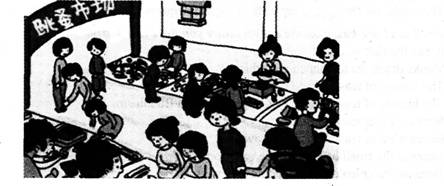四级课程经典
0基础速升HOT
去试听
四级1对1
定制化
寒假跟学攻略
0元
阅读冲刺 200+大招
0元
四级核心词带背
9.9
四级真题答案
免费
VOA&BBC原声听力
热门
《满绩攻略》免费
132个保研故事免费
考研真题大全
免费
考研特训营
免费
27考研书单
省钱版
考研AI择校
智能
Part I Writing.(30 minutes)
11、Directions:For ths part,you are allowed 30 minutes to write a short essay based on the picture below.You should start your essay with a briefaccount ofcollegeflea market and then discuss the advantages and disadvantages of college flea market.You should write at least120words and no more than 180.

Part II Listening Comprehension.(30 minutes)
Section B
Directions: In this section, you are going to read a passage with ten statements attached to it. Each statement contains information given in one of the paragraphs. Identify the paragraph from which the information is derived. You may choose a paragraph more than once. Each paragraph is marked with a letter. Answer the questions by marking the corresponding letter on Answer Sheet 2.
根据以下资料,回答47-56题:
Directions:In this section,you are going to read a passage with ten statements attached to it.Each statement contains information given in one of the paragraphs.Identify the paragraph from which the information is derived.You may choose a paragraph more than once.Each paragraph is marked with a letter.Answer the questions by marking the corresponding letter on Answer Sheet 2.
Here’s the Totally Amazing Wonder Material That Could Revolutionize Technology
A.In the technology industry,every new product or service seems to come with the promise that it is an innovation with the potential to change the world.Graphene(石墨烯),a form of carbon,might actually do just that.
B.“Graphene is a wonderful material,”Jeanie Lau,a professor of physics at the University of California at Riverside,told Fortune.“It conducts heat 10 times better than copper and electricity 100 times better than silicon,is transparent like plastic,extremely lightweight,extremely strong,yet flexible and elastic.In the past decade,it has taken the scientific and technology communities by storm,and has become the most promising electronic material to supplement or replace silicon.”
C.Graphene has already found its way into a number of compelling applications,Lau said.For instance,“since it is both transparent and electrically conductive—two attributes rarely found in the same material in nature—it has tremendous potential as the transparent electrode in monitors.displays;solar cells,and touch screens,”she explained.“Companies such as Samsung that invest heavily in this area have already secured patents,produced prototypes,and are expected to bring products to market in a few years.”Wearable electronic devices,aviation components,broadband photodetectors(光电检测器),radiation-resistant coatings,sensors,and energy storage are among numerous other areas of active research.Lau said.
D.For many researchers and investors,the ultimate application is graphene-based transistors,the building blocks of modem electronics.But getting there may take some time.
A child of graphite
E.First produced in a lab back in 2004,graphene is essentially a single layer of pure carbon atoms bonded together in a honeycomb lattice so thin it’s actually considered two-dimensional.“We generally regard anything less than 10 layers of graphene as graphene;otherwise,it’s graphite,”said Aravind Vijayaraghavan,a lecturer in nanomaterials at the University of Manchester.
F.Even“graphene”is a bit of an umbrella term.“To oversimplify,there are two major types of graphene,”Michael Patterson,CEO of Graphene Frontiers,said.The first:“Nanoplatelets,”which are powders or flakes made from graphite.These have been around for a while and are“not really super-sexy,”Patterson said.“You mix them into polymers(聚合物)or inks or rubbers to make them conductive.”In flake form,graphene is already on its way to becoming a commodity,Patterson added.The other type—in sheet or film form—is where graphene’s biggest promise lies.Graphene sheets have“incredible potential for electronics,”Patterson said.In the near term,that potential may manifest in situations where the quantity requirements are“not that great”and where quality or conductivity doesn’t have to be as high,such as in basic touch-screen applications,he said.Products that use graphene in this way could arrive to market in the next six to 1 2 months.
G.Looking a little further out,graphene can be employed in membranes used for water desalination.Lockheed-Martin already has a patented product known as Perforene.“It’s real and it works,but it won’t be economically viable until the product reaches an industrial scale where the cost is measured in pennies per square inch”rather than dollars or tens of dollars per square inch,Patterson explained.
“That’s where we’re working today.”
‘It’s expensive and low-capacity’
H.But use of graphene in semiconductors—the technology’s Holy Grail—is likely a decade away.“Many of the challenges presented by graphene are common to most new materials,”Paul Smith,a patent associate with the Intellectual Property Law Group at Fenwick & West,told Fortune.“The trick is figuring out how to synthesize graphene in a way that first is manufacturable beyond lab scale;second,preserves the desirable properties of the material;and third,can be integrated into a product or technology.”
D.Synthesizing graphene in sheet form is considerably more expensive and time-consuming than producing graphene flakes.Whereas the latter typically involves a“quick and dirty”process by which bulk graphite is disassembled into millions of tiny pieces,Lau explained,large sheets of graphene are carefully“grown”on substrates(基板)such as copper,germanium,or silicon carbide.
J.Graphene sheets are also prone to defects and“very difficult to make in good quality,”Ron Mertens,owner and editor of Graphene-Info.tom,said.Production capacity is also very limited.“There are thousands of small companies that can make graphene,but it’s expensive and low-capacity,”Mertens said.alround wafer measuring one inch in diameter,for instance,costs about$1 00,he added.
K.An even thornier obstacle on the way to graphene transistors is the fact that the material has no“band gap,”an essential property that allows transistors to be turned on and off without leaking electronic charge in the“off”state,said Elias Towe,a professor of electrical and computer engineering at Carnegie Mellon University.
L.“Band-gap engineering has been and remains the biggest challenge in the development of graphene transistors and computer chips.”Lau said.It requires controlling the material almost down at the atomic level,and“that’s really pushing the edges of existing technology,”Patterson said.“In 10 years,we’11 start to see these problems solved.”
‘It is largely a matter of time’
M.If graphene is to succeed as a replacement for silicon,every unit of cost and performance will make a difference,Towe said.
N.“Silicon is hard to displace,with all the billions dollars of investments made in manufacturing infrastructure,”he said.“A replacement for silicon has to offer extraordinary performance at extremely rock-bottom cost to compel industry to change its way.”
O.Though graphene is just 10 years old—in contrast,use of silicon in transistors dates to the early 1950s—considerable progress has already been made.For example,the largest graphene sheet was produced by hand in a laboratory eight years ago;its width was less than that of a human hair.“Nowadays,roll-to-roll printing of graphene sheets up to 1 00 meters long has been achieved,”Lau said.“With the increasing interest,investment,and research in graphene-based technology,I think it is largely a matter of time before the economy of scale kicks in and truly low-cost,large-scale production ofhigh-quality graphene is accomplished,”she added.
新东方英语四级好课免费听↓↓↓
| 课程名称 | 课程亮点 | 试听 |
| 【小班课】英语四六级零基础无忧计划 | 1V1私教 | 免费试听 |
| 【零基础】四六级全科专项突破 | 零基础速升 | 免费试听 |
| 【公开课】听力/阅读/写作/翻译提升 | 名师小课 | 免费试听 |
| 【经典】英语四六级全程班 | 超高性价比 | 免费试听 |
| 了解更多四六级课程 | ||

 资料下载
资料下载
新东方四级词汇乱序版电子资料
发布时间:2020-04-15关注四六级小助手服务号
回复【过级词汇】获取
英语口语8000句电子书籍
发布时间:2020-04-15关注四六级小助手服务号
回复【过级词汇】获取
新东方在线[四六级王牌团队]典藏笔记(...
发布时间:2019-10-25关注四六级小助手服务号
回复【典藏笔记】获取
英语四级过级备考资料:经验+计划+语法
发布时间:2019-10-25关注四六级小助手服务号
回复【过级经验】获取
英语四级阅读讲义+长难句+翻译
发布时间:2019-10-25关注四六级小助手服务号
回复【阅读礼包】获取
英语四级写作模板|范文|句型|讲义
发布时间:2019-10-25关注四六级小助手服务号
回复【写作指导】获取
新东方·大学英语四级听力特训附音频
发布时间:2019-10-25关注四六级小助手服务号
回复【听力礼包】获取
英语四级口语考试练习题目【word版】
发布时间:2019-10-25关注四六级小助手服务号
回复【口语提升】获取
俞敏洪词根词缀记忆法
发布时间:2019-10-25关注四六级小助手服务号
回复【过级词汇】获取

关注四六级小助手服务号回复【典藏笔记】获取
关注新东方四级服务号,
获取学习资料

 推荐阅读
推荐阅读
备考英语四级模拟题,重点是熟悉各部分的题型和考点,多练习以提高答题技巧和时间管理能力,增强应对考试压力的能力。新东方在线为大家整理了2024年12月大学英语四级翻译模拟:天安门广场,一起来测试吧!
备考英语四级模拟题,重点是熟悉各部分的题型和考点,多练习以提高答题技巧和时间管理能力,增强应对考试压力的能力。新东方在线为大家整理了2024年12月大学英语四级翻译模拟:旅游业,一起来测试吧!
备考英语四级模拟题,重点是熟悉各部分的题型和考点,多练习以提高答题技巧和时间管理能力,增强应对考试压力的能力。新东方在线为大家整理了2024年12月大学英语四级翻译模拟:中国的多样化,一起来测试吧!
备考英语四级模拟题,重点是熟悉各部分的题型和考点,多练习以提高答题技巧和时间管理能力,增强应对考试压力的能力。新东方在线为大家整理了2024年12月大学英语四级翻译模拟:义务教育,一起来测试吧!
备考英语四级模拟题,重点是熟悉各部分的题型和考点,多练习以提高答题技巧和时间管理能力,增强应对考试压力的能力。新东方在线为大家整理了2024年12月大学英语四级翻译模拟:旅游增长,一起来测试吧!


 专项提升公开课
专项提升公开课
一站式扫清备考障碍!
价格 : ¥229元
限报人数:1000人
全新重磅升级!专为基础薄弱打造
价格 : ¥279元
限报人数:1000人
32h 全方位拯救听力
价格 : ¥1799元
限报人数:1000人
 资料下载
资料下载
关注四六级小助手服务号
回复【过级词汇】获取
关注四六级小助手服务号
回复【过级词汇】获取
关注四六级小助手服务号
回复【典藏笔记】获取
关注四六级小助手服务号
回复【过级经验】获取
关注四六级小助手服务号
回复【阅读礼包】获取
关注四六级小助手服务号
回复【写作指导】获取
关注四六级小助手服务号
回复【听力礼包】获取
关注四六级小助手服务号
回复【口语提升】获取
关注四六级小助手服务号
回复【过级词汇】获取

 阅读排行榜
阅读排行榜
 相关内容
相关内容